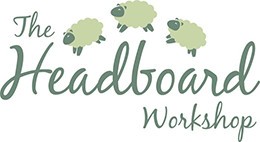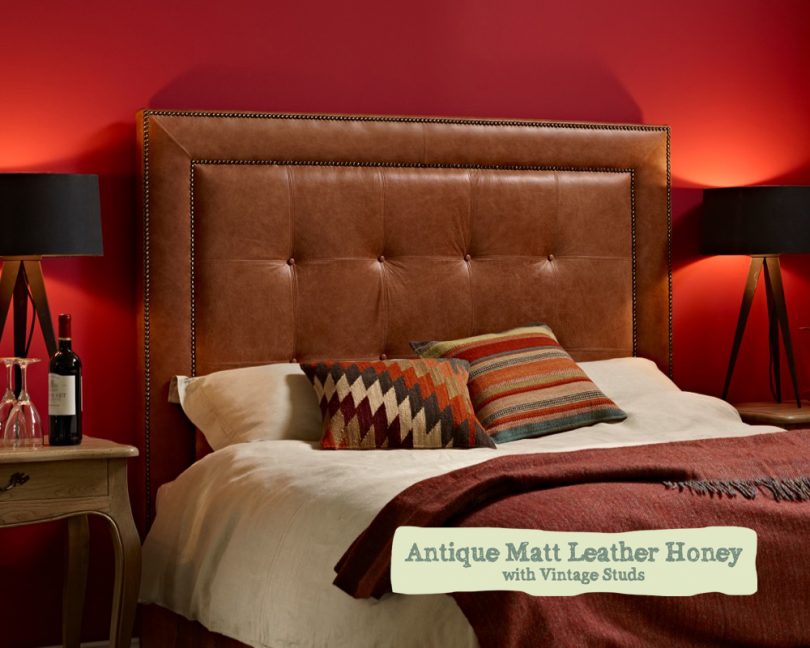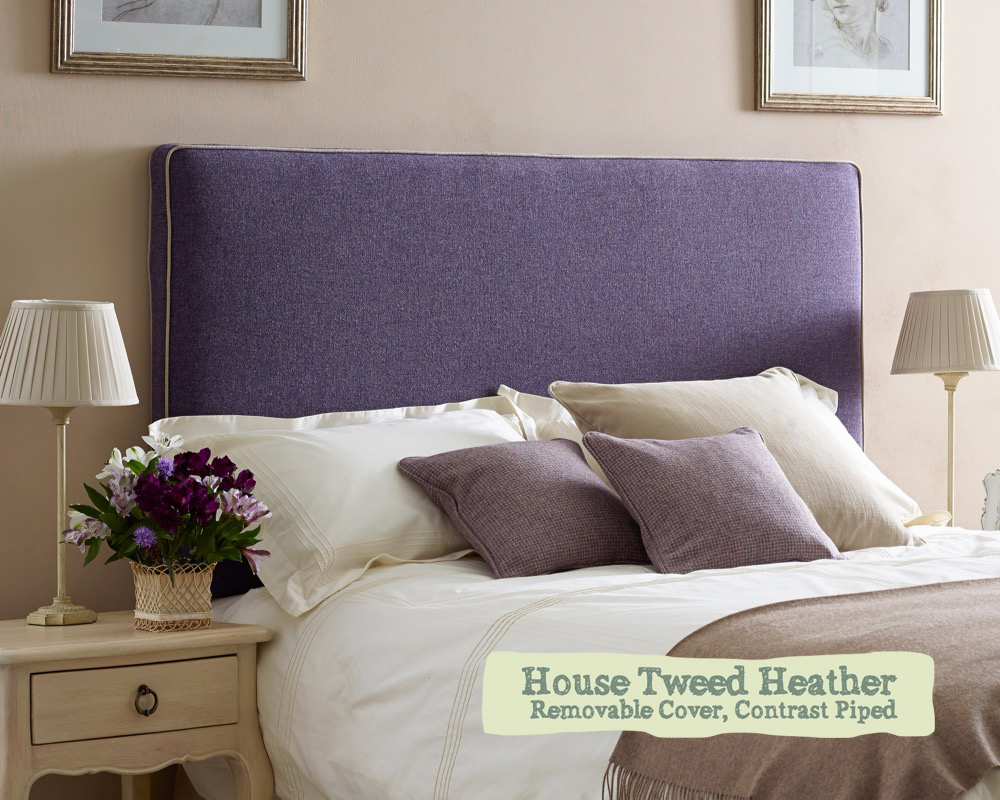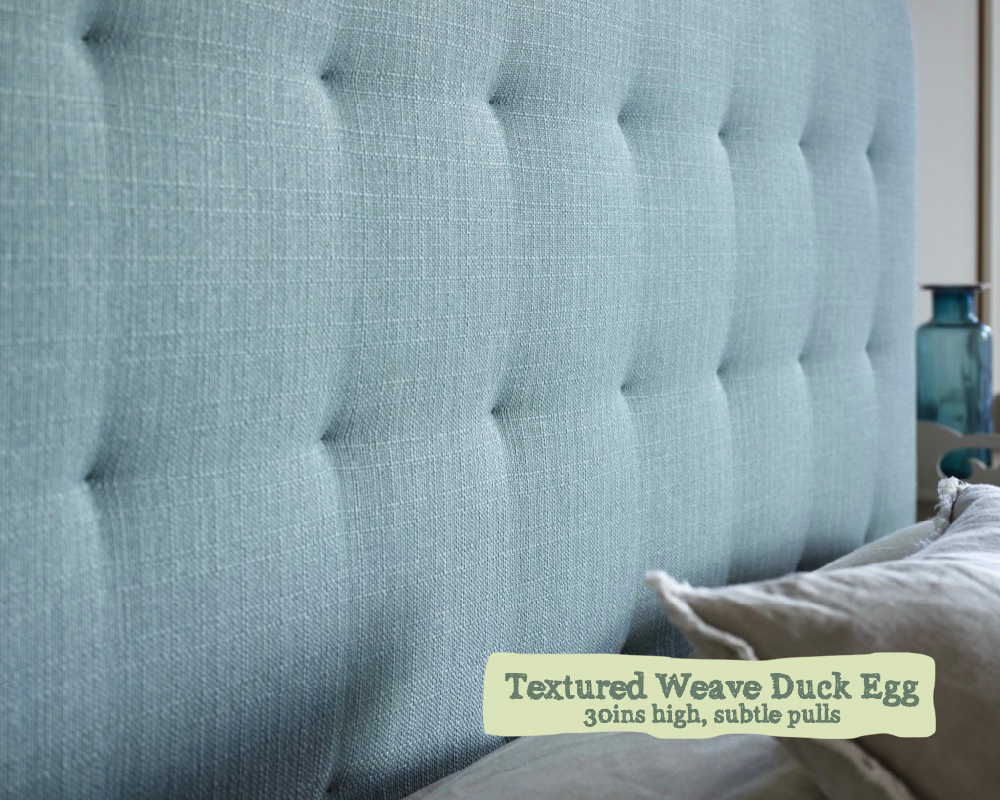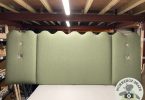Decoding the world of headboard design need not be a challenge. As always, we are here to help!
Here’s our easy reference guide to some of the common terms that we use on our website to help you decide on the very best headboard for you.
We welcome your questions and are always happy to chat to you about our wide range of beautifully upholstered products so that you can buy with confidence.
Types of Headboard
Standard Headboard
Our standard headboards are designed to be affixed to your bed or to your wall and rest on top of your mattress.
Floor Standing Headboard
This type of headboard rests on the floor and has an upholstered panel that goes behind your bed and mattress. It is made in one piece and so care should be exercised when considering installation access. Any of our standard headboards can be adapted to be floor standing. In this case, they are supplied with wall retaining brackets for fixing to your wall as the bulk of the weight is taken by your floor. Features include a skirting board cut out for ‘back to the wall’ fitting.
Winged Headboard
This is a standard headboard that has matching upholstered ‘wings’ attached to the sides that project into your room. The wings reach to the ground whilst the headboard rests on your mattress with the choice of fixing to the bed base or to the wall, as you prefer.
Our workshop manager will contact you for your measurements and our friendly delivery team will fix your new winged headboard to your bed for you when they visit.

Winged Iona Headboard
Scroll Top
Our Sanday Headboard stands away from the wall and is floor standing by default. It has clever concealed mounting slots that allow for fixing to your bed which are then covered using a Velcro sealed flap. A scroll top headboard like the Sanday features a rounded back that rolls out and away from the top of the headboard.
Similarly, our Iona bed is a scroll top bed and is built to be freestanding.

Floor Standing Sanday Headboard
Bed Measurements
Mattress Height
This is where the top of your mattress sits from the floor and includes the bed base.
Mattress Depth
This is the height of the mattress only and does not include the bed base.
Bed size
This is the width of your bed. We make our headboards allowing for an extra 15mm either side for a luxury finish. By doing so, your headboard looks generous and takes into account the extra few centimetres needed to accommodate your duvet and covers.
Essential Add-ons
Pillowstop
Our unique pillowstop is a firm favourite with designers!
It is a thin piece of matching upholstered board that is made as an integral part of your headboard. It is designed to slot down behind your mattress and make the gap between your divan and headboard tidier. This is particularly suited to scenarios where your head end can be seen from the side on entering your bedroom.
A retro-fit pillowstop is also available to order on request.

Our unique Pillowstop is a favourite with Interior Designers!
Fabric protector
This is a water based solution that we can apply in our workshop to help protect your fabric headboard from stains and spills. It is colourless and odourless. It won’t change the look, feel or smell of your headboard in any way. What it does do is provide an invisible ‘force field’ to your new headboard and helps to slow the penetration of water and oil based stains into the fibres of the fabric.
This will give you the opportunity to grab a cloth and remove the stain before it becomes ingrained.
Removable covers
Our Harris and Caldey Headboards are available with removable covers. Removable covers are upholstered in your choice of fabric and fitted using Velcro fastenings to achieve the correct tension on the front of your headboard. The velcro is sewn onto flaps on the reverse of the headboard, and then rebated for a flush to the wall finish. These are ideal in high traffic areas, or, for giving your room a quick makeover.
Most customers order two covers so that there is one at the laundry and one on the headboard at all times.
Trims and Decorations
Piping
This is a fabric covered cord that is used as decoration on your headboard.
Self Piped
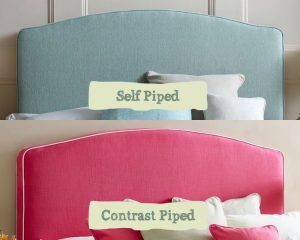
The Headboard Workshop Piping Options
Your piping is made using the same fabric as the main headboard.
Contrast piped
Your piping is made in a fabric that compliments the main fabric but is different.
Shallow Buttoning
Buttons are gently pulled through from the front side of your headboard to give a gentle dip, without distorting the fabric shape.
Deep Buttoning
Buttons are pulled through from the front side of your headboard to give a deep and sumptuous cushioned effect. The excess fabric is then pleated to give a pleasing diamond pattern between the buttons.
Self Buttoned
Shallow or deep buttons are covered in the same fabric as the headboard.
Contrast Buttoned
Shallow or deep buttons are covered in a fabric that does not match the main headboard fabric.
Crystals
Swarovski crystal buttons can be used on your headboard as a glamorous alternative to fabric covered buttons.
Pulls
A small stitch is passed through the padding and fabric of the headboard front and is pulled to achieve a small but defined dip in the fabric. We love our Islay Headboard for it’s contemporary pulls and minimalist design.
Studding
Raised metal studs are applied to the front of your headboard in rows for decorative effect. They can be nailed close together or with a gap to achieve the desired result.
Pleats
The fabric is folded and creased in small increments to achieve a textured look. Great examples of this include our Tresco Headboard.
Darted corners
This is where the fabric rolls around the corner and a small line of stitching is made to absorb the excess fabric as it merges to the back to give a soft and rounded corner profile.
Boxed edge
A gusseted border to a headboard. This can be piped for interest. The Kingsize Mull Headboard is an excellent example of this.
Fitting and Installing
Wall Mounting Pack
An easy way to mount your headboard to the wall. A wall mounting pack consists of an MDF split batten. One half will arrive affixed to the back of your headboard and another is affixed to your wall. Simply offer the headboard up to and over the wall batten to hang.
Full instructions are sent with your headboard and should only take a handy person ten minutes to install. Wall mounting packs are advisable for any headboard over 34” tall.
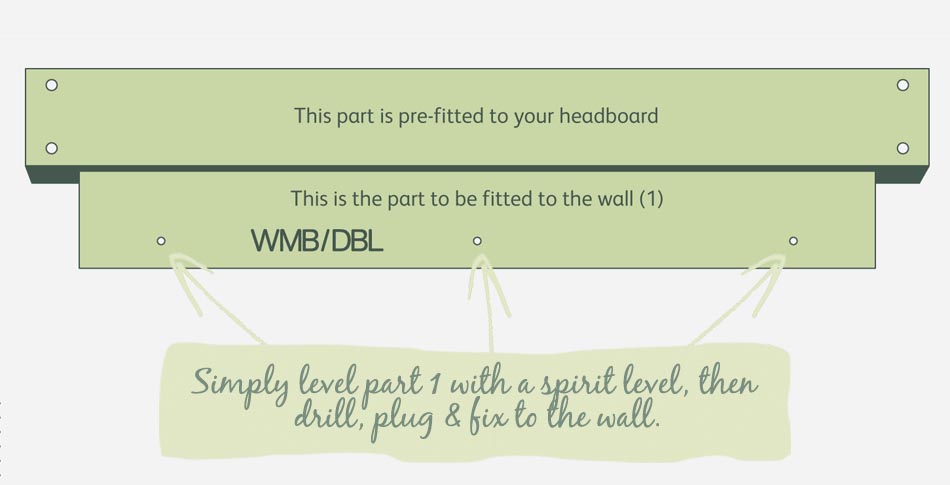
Plywood Moulded Struts
These sturdy wooden struts are designed and manufactured just for us. They are made to recess into the back of the headboard for a ‘back to the wall’ finish. Our delivery team will fit your struts to your headboard and to your bed on arrival and take away the rubbish.
Plywood moulded struts are complimentary and are supplied as the default for all headboards where a wall mounting pack is not ordered.
Wall Retaining Brackets
For floor standing headboards where the weight is taken by the floor, we supply wall retaining brackets to safely ensure that the headboard does not tip forward.
Skirting Board Cut Out
Likewise, for a back to the wall effect, your floor standing headboard will feature a cut out for your skirting board. We will contact you for your specific skirting dimensions to be sure of an excellent finish.
Compliance
Back Coating
Your fabric is sent to a third party flame proofing facility so that a fire retardant substance can be applied to the reverse side of the fabric. Back coating is necessary when your fabric is made from less than 75% natural fibres.
FR interliner/Barrier Cloth
For fabrics that are made up of more than 75% natural fibres, it may be possible to use a fire retardant interliner to avoid the expense of flame proofing treatment. In this instance, a treated barrier cloth or interliner is sufficient to make your fabric comply with regulations.
Crib 5
Crib 5 is the commercial grade of fire retarding for items that are upholstered for use in a commercial environment. For instance, a hotel.
Fabric
Pattern Repeat
If your fabric is patterned, at some point the pattern will stop and be repeated. The pattern repeat is the distance between the first pattern and the start of the next.
Railroading Fabric
To railroad a fabric simply means to turn it on it’s side to remove the need to join the fabric. This is best suited to plain fabrics and is extremely efficient on fabric usage. The maximum height of the headboard is then dictated by the width of the piece of fabric.
‘COM’
We use this acronym as a shorthand for Customer’s Own Fabric. We welcome you to send us your own fabric for upholstering onto your new headboard and are the experts.
There are a few things we will need you to do to help make this process easy and we will chat them through with you at the time of enquiring.
We can also help to make sure that your fabric will comply with fire legislation.

Swatch
A swatch is sometimes referred to as a fabric sample. Either way, It’s a small piece of fabric that is sent to you to choose your favourite fabric from, match up your colour scheme to your new headboard or to confirm the fabric you have selected.
You can add FREE fabric samples to your cart for next day postage from us.
Nap
The nap or ‘pile’ on some fabrics is the uniform direction in which the fibres lie. For example, a velvet feels different to the touch brushed in two directions. The light can affect the colour qualities of a velvet depending on which way the pile is facing, or ‘run’.
Where possible, our workshop craftsmen will run the pile from right to left. Great care is taken to label our swatches that have a pile in the direction of use.
Fabric Direction
If you choose a patterned fabric, we will ask you for confirmation of which direction you would like the pattern to face.
This may seem obvious in 9/10 cases of Customer’s Own Fabric but we would never wish to make the wrong judgement.
A patterned fabric will have a top to its’ design – if your fabric will need to be run so that the pattern remains in the correct orientation, joins may be required to make a panel big enough to use on some of our headboards that are larger than a width of fabric.




